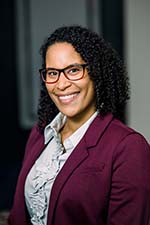Charisse Pickron, PhD, ICD assistant professor and director of the Child Brain and Perception Lab, was recently interviewed on Minnesota Public Radio’s Early Risers podcast. The segment is titled “How Babies Start to Learn About Race.” The podcast discusses the natural abilities infants and children have to recognize patterns and form connections and the ways this applies to race recognition and implicit bias in childhood.
Currently, her research gathers information on the age at which children begin to make distinctions between racial groups. “What my research shows is that a two year old has some rudimentary grouping of a white face and a black face, they’re seemingly making separations there,” says Pickron.
Additionally, from ages 2-5 her research demonstrates the presence of “in-group love” preferences in the children they have observed. From a young age, children are able to identify differences between human faces. They then form preferences for faces of the race they have more familiarity with. In order to diminish the effect of these preferences, Pickron has found that “we want to reduce the use of generalized labels.” She recommends assigning names to book characters of different races and discussing their fictional traits to help children create distinctive individual identities for people of all racial groups.
“When we say ‘look at Marcus, Marcus loves to jump and run and read books’, then we’re learning Marcus is somebody who also likes to read books, and jump, and play on the playground just like me,” Pickron says. “The power of individual naming is being shown in the preschool age that can actually reduce implicit racial bias.”
Listen to the full interview here.




